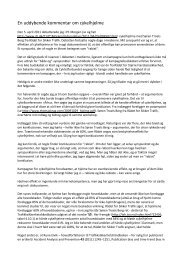Cykling, motion, miljø og sundhed - Thomas Krag
Cykling, motion, miljø og sundhed - Thomas Krag
Cykling, motion, miljø og sundhed - Thomas Krag
You also want an ePaper? Increase the reach of your titles
YUMPU automatically turns print PDFs into web optimized ePapers that Google loves.
Research shows that the risk of accidents is counterbalanced to a great extent by the positive effect<br />
of cycling on physical health.<br />
What prevents people from cycling?<br />
Many people claim that they would cycle more if conditions for cycling were better. Most of the<br />
people who do not cycle find the distance to and from work too far, say that cycling would take too<br />
much time, that they have too much to carry, and that the weather often is too bad. Others point out<br />
that there are too few cycle paths or that the existing paths are in poor condition. However, when<br />
they actually try it out, many find that cycling is less time consuming than they believed it would<br />
be, and that it rains less than they thought. Research shows that people in households with one car<br />
very rarely use their bicycle. If there is more than one car in the household people cycle even less.<br />
Many of those that do cycle give the reason that cycling provides good exercise and considerable<br />
freedom of movement.<br />
Younger people express the same reservations as grownups, although theft is also a very important<br />
issue for the former. Few adults consider risk of accidents a reason for not using a bicycle. But<br />
accidents play an important role in adults’ deliberations about whether to allow their children to<br />
cycle. When they are asked, many children say they prefer to cycle to school rather than be taken by<br />
car.<br />
Campaigns urging children to cycle more can have great effect. As many as 70,000 children took<br />
part in the school campaign “All Children Cycle” organized in 2003 by the Danish Cycle<br />
Federation. Of this number 15,000 children where “new” cyclists, and after the campaign had ended<br />
5,000 children continued to use their bicycle.<br />
Campaigns urging children to cycle more can have great effect. As many as 70,000 children took<br />
part in the school campaign “All Children Cycle” organized in 2003 by the Danish Cycle<br />
Federation. Of this number 15,000 children where “new” cyclists, and after the campaign had ended<br />
5,000 children continued to use their bicycle.<br />
National pr<strong>og</strong>rams for cycling<br />
Denmark and the Netherlands are the Western countries where people cycle the most. It is<br />
characteristic for these two countries, however, that suggestions about stimulation of cycling are<br />
rarely raised. Even though these countries in principle have a cycling policy that encourages people<br />
to cycle more, cycling is only cursorily mentioned in national campaigns for better health and more<br />
exercise. Moreover, investments to make cycling more attractive are primarily left in the hands of<br />
local municipalities. In contrast to Denmark and the Netherlands, countries such as Norway, Great<br />
Britain, Belgium (especially Flanders), and Canada have a political agenda on which cycling is<br />
listed as a means to improve health in general and to stimulate physical exercise. Efforts in Great<br />
Britain and Canada, where there are relatively few cyclists, have as yet only rarely resulted in<br />
practical political initiatives. But in Norway, and especially in Flanders, large federal funds,<br />
earmarked for stimulating cycling, have been channeled to municipalities.<br />
The above-mentioned countries have all set political goals for how much cycling should increase<br />
within a specified time frame. Such a goal was also formulated in Denmark in 1993, but since then<br />
it seems to have been forgotten. In Denmark there are plans to improve health in general, and to<br />
reduce illnesses that stem from physical inactivity and obesity. Cycling is mentioned in these plans<br />
as a means, but it does not play a prominent role. Moreover, the ministry of traffic is practically<br />
absent from both the development and realization of such plans. After the change of government –<br />
to a liberal-conservative one - in 2001, efforts to diminish physical inactivity and obesity were<br />
- 13 -



